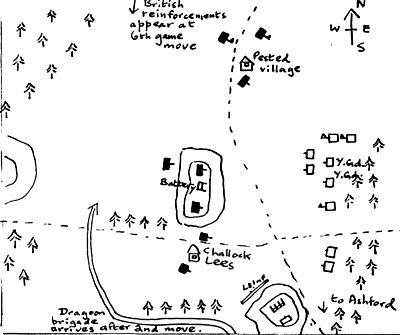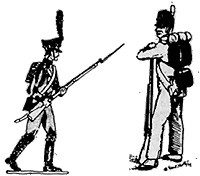(A campaign game played by the Mid-Herts Group; for strategic rules see June "Newsletter"; basic numerical representation: one figure = 50 men, one gun = a battery of 6).
Campaign in Kent, May 15th Onwards
It will be remembered that the large French landing at Harwich had been largely a failure, the units being drives back to their transports after two hard-fought battles. But some advantage came from the situation after all. Duriag the previous few days the French intelligence service had been concentrating on plotting the whereabouts of all the various British armies. Many had been met in action, the existence of others was known as a result of French probes with cavalry towards the main towns and road centres. Adding all the known armies, the French came to the staggering conclusion that Sussex and Kent must be undefended Berthier (Neil Cogswell, modestly declining to represent the Emperor) running the campaign from Paris (Welwyn Garden City!) without seeing any of the battles and with the help of only scraps of information, had been assuming all along that the British would put their main strength across the short routes to London, and that Kent and Sussex would be full of troops. Now, realising that he had only to transfer the beaten army to Whitstable in order to establish a base near to London but at least five days' march from the main British armies (still up at Harwich), he ordered the transports to the Kent port, where they landed on May 15th, and began next day to move towards Maidstone.
It would take the victors of Harwich five days to march back to London and then out to attack the Whitstable area. In that time two small fleets of supply ships would land another 3,000 men at least the port could be partly fortified, and the Kent Republicans called to arms. Better still, the French had a chance to take Maidstone with its forts and Medway bridge. So a cavalry screen was sent to contain the Chatham garrison and the bulk of the French marched for Maidstone.
Unfortunately, they were just too late to snatch this prize. The British, with the sound strategic foresight which they showed in all the initial stages of the campaign, had moved ever to Maidstone during the Harwich campaign a small reserve army which had been held at Reading initially. The idea was to cover London against any thrust from the South.
The French fell back to a position East of Chatham, and, when they learned soon afterwards that the "London" (or main British) army was passing through the capital on its way to Kent, withdrew slowly to a strong position at Dunkirk Hill, covering both Whitstable and Canterbury. A large force of dragoons, the first reinforcements from France, which had set off from Whitstable on the 16th on a sweeping raid through Ashford in the direction of Sussex, was recalled with difficulty, although in the long run their slow return was a key factor in the French victory on the 21st.
By the 20th the British has passed through Rochester and halted at dusk at Faversham. This London army, nearly 15,000 strong, planned to advance slowly next day against the main French position whilst the smaller army from Maidstone, which had no% reached Challock Lees crossroads north of Ashford, moved quickly from the South-went to turn the flank of the Dunkirk Hill lines. But during the 20th the French had been further reinforced, this time with some infantry, and so felt able to leave a holding force at Dunkirk Hill and march south to Chilham on the Canterbury road with all the remaining Youag Guard units and strong artillery and heavy cavalry to try a desperate attack on the weaker British force before the army at Faversham could come down too assist. The dragoons at Ashford (which town had not been reconnoitred by the everconfident British) were ordered to strike at the same target from the south.
 Battle of Challock Lees, May 21st
Battle of Challock Lees, May 21st
(Note: the game which represented this action was begun with the two Players being told that both sides had "reinforcements on the way" but without any idea an to what was coming and exactly where, although of course the general direction could be guessed roughly. The tactical rules used on this occasion were substantially tkose given by Neil Cogswell in the "Newsletter" in October, 1968).
The French marched from Chilham village 2 hours before sunrise, and by 8 a.m. were deployed north and south of the crossroads. Not knowing the British dispositions, naturally, they planned a strong attack by the Guard and heavy cavalry on the ridge north of the crossroads, hoping thus to drive the British back southwards away from the main Faversham army. They were disconcerted to find on sighting the ridge at last that the British were deployed in strength on it, holding the area to the south with only weaker or poorer-quality troops. There wis a risk that the flanking force of dragoons would not be able to work round behind the main British position in time.
But the French went ahead with their plan. At first the British held their own, beating off the first attack of infantry and sending their small cavalry force circling round the French right, cleverly tying down the French cavalry. But the second wave of French infantry carried the ridge, with the help of some heavy cannon fire raking the right flank of the British. By this time the French dragoons had arrived on the battlefield, and the British militia infantry had begun to retire from the Challock Lees houses. By ill luck, at this moment some regular light infantry in this area broke under fire from superior French voltigeurs charging down on them from the main battery, and in their rout carried some of the militia with them.
Then the British horse artillery, retiring from the ridge, was overrun by the dragoons, who were only stopped by desperate resistance from some British Line infantry 1 mile west of the ridge. A division of British infantry now appeared from the north, four regiments, which were ordered to retake the ridge and help drive the French back along the Canterbury road.
But everything went the way of the French. In melee after melee on and to the west of the ridge the British morale was wretchedly low, and regiment after regiment broke under infantry attack from the ridge itself or under dragoon charges from the west. The French left wing now moved up to north of the cressroads, the cannon bombarding the division from Faversham, the infantry moving east of the Faversham read to support an attack by the French right wing cavalry which finally halted the British counter-attack (which is fact had gallantly reached the north end of the ridge).
Both British generals with the original force had by now been killed and lose than half the infantry reached the safety of the thick woods to the west. The French took both batteries and 2 standards. Dragoons pursued fugitives along the Maidstone road, taking over 1,000 prisoners, and the Faversham units retired northwards. The French remained in possession of the battlefield, only withdrawing towards Chilham later is the afternoon when the British from Faversham started probing towards the Chilkam area - although there was no general movement of this main British army towards Whitstable throughout the 21st, as the outcome of the Challock Lees action was awaited, the British still being keen to turn the Dunkirk Hill position from the south.
More 1810 Invasion
Back to Table of Contents -- Wargamer's Newsletter # 104
To Wargamer's Newsletter List of Issues
To MagWeb Master Magazine List
© Copyright 1970 by Donald Featherstone.
This article appears in MagWeb.com (Magazine Web) on the Internet World Wide Web.
Other articles from military history and related magazines are available at http://www.magweb.com
